#QuadStepNoiseReduction
Explore tagged Tumblr posts
Text
LG OLED 65W8PLA TV Review

Tough competition and the rapid development of digital technologies provoke high dynamics in the consumer electronics segment. Of course, rapid changes are most pronounced in the segment of high-tech TVs. For example, over the past few years, companies have virtually abandoned the 3D function due to limited content and have stopped producing plasma TVs due to the high cost of their production. On the other hand, today many models even of the middle level support SMART TV and this trend continues to evolve. In addition, LG has already demonstrated the Signature Roll Up OLED TV model with flexby screen. At CES 2019, 260 flexible OLED signage screens, connected together to imitate a waterfall struck the imagination of the most imperturbable viewers.
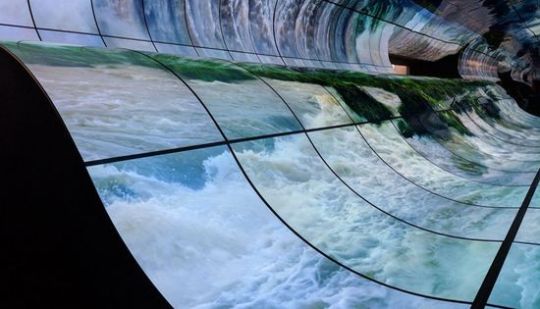
Of course, the invention and development of OLED and QLED technologies fully comply with this trend. As known, OLED (organic light-emitting diode) technology uses radiation of diode under the influence of electricity. Modern models use RGB or WRGB OLED technology with 3 or 4 subpixels, respectively.
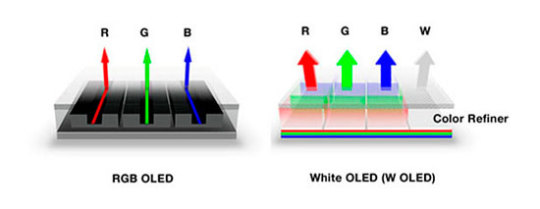
LG TVs use WRGB OLED (white + red + green + blue subpixels) technology. According to LG, the fourth subpixel reduces the cost of production while improving brightness, contrast and color rendering. As known, the company manufactures panels on LG Display enterprises, which, of course, further expands the possibilities for optimizing the technology. In 2018, the company offered several OLED series, including B8, C8, E8, G8 and W8 series. LG W8 Wallpaper OLED TV with Google Assistant and Amazon Alexa integration is LG's 2018 flagship. LG SIGNATURE AI OLED TV Picture-on-Wall W8 Series includes 77-inch (76.7-inches diagonal) 77W8 model and 65-inch (64.5-inches diagonal) 65W8 model.
Design
Of course, an unprecedentedly thin screen with an OLED panel thickness of only 2.57 mm is the main key feature of the LG Signature. The G series uses a stand that rotates 90 degrees when mounted on a wall. The more spectacular W series uses a thin cable to connect the screen and the base with the soundbar. Of course, such an engineering solution eliminates the possibility of installing a TV on the table. The OLED panel is attached with magnets to the mounting plate, which, in turn, is attached to the wall.

In addition, an inconspicuous flexible cable can easily be masked with a decorative strip. In this case, the OLED panel is visualized as a large thin picture on the wall.
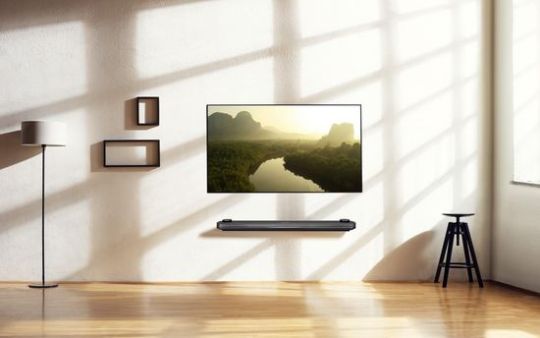
The TV has two universal tuners and an interface for connecting paid channels. Four HDMI inputs with 4K @ 60 Hz support provide connection for external sources. 2 USB inputs are provided for external drives and peripherals. The home network uses an Ethernet connector for cable and Wi-Fi with 802.11.ac support. The base with the soundbar is convenient for placing the traditional LG Magic Remote.
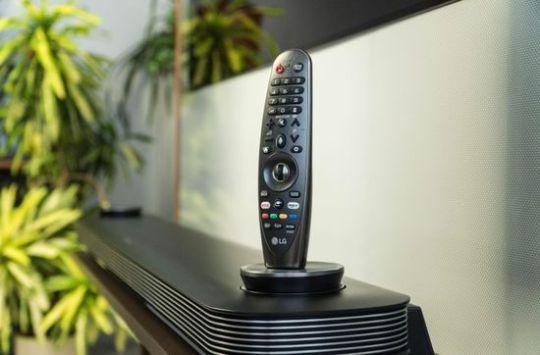
Gyro Magic Remote supports control with gestures or arrows around the scroll wheel. In addition, it has a four-way joystick in the center. Moreover, the model supports voice input. The new Alpha 9 has improved CPU and GPU performance and 35% more RAM.
Other features
Smart TV uses webOS 4.0 with a very convenient and simple menu. Compared to last year, the operating system has an updated LG app store interface and a search button in the upper right corner. In addition, the TV supports ThinQ, which significantly improves the recognition of voice commands. The model also supports control using a smartphone through the LG TV Plus app. But, of course, the smartphone and TV must be on the same network. Additionally, TV Plus activates the installed apps, turns on the TV by timer and provides content transfer from the smartphone. Audio 4.2 system includes a 60-watt soundbar with Dolby Atmos support.

Two hidden subwoofers on the edges of the soundbar automatically rise when you turn on the TV. W8 provides surround, rich and deep sound with good detail mid and high frequencies, significantly exceeding its competitors by this criterion. In addition, upward speakers shift the virtual point source to the screen area, enhancing the stereo effect. Additionally, LG TVs 2018 supports 4K @ 120 fps video mode, but only for video content in streaming services, such as Netflix or on an external devices, via USB. Unfortunately, the lack of HDMI 2.1 limits this feature. Therefore, the model supports only 4K @ 60 fps or 1080p @ 120 fps as a game monitor.
Image quality
LG OLED65W8PLA uses a 10-bit OLED panel with a frequency of 120 Hz, a resolution of 3840 × 2160 pixels and a diagonal of 65 ″ or 77″. It supports all HDR standards, including HDR10, Dolby Vision, Hybrid Log-Gamma (HLG) and Advanced HDR from Technicolor. The high-performance Alpha 9 significantly improved image processing algorithms. This list includes Quad Step Noise Reduction, Frequency Based Sharpness Enhancer, Object Depth Enhancer, Billion Rich Color and Ultra Luminance Pro technologies. As a result, the TV improved the noise reduction and color accuracy, playback of highly dynamic scenes and the scaling HD content to 4K and expanded the color gamut. In addition, LG has developed two new HDR processing modes for the popular HDR10 Pro and HLG Pro, using dynamic metadata instead of static. In fact, this TV supports analogue of HDR10 +. Of course, the image quality makes a huge impression even on the sophisticated viewer because of the absolutely black, which provides tremendous contrast and image depth.

Maximum viewing angles of the OLED-matrix retain excellent playback quality, including brightness, contrast, saturation and color accuracy when viewed from any point.
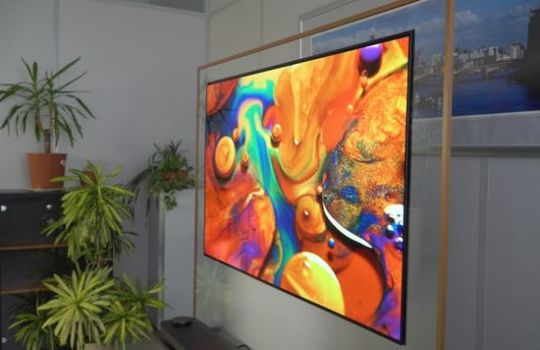
Additional white pixel of WRGB technology provides maximum brightness. As known, this value OLED-panel depends on the overall image brightness. In other words, the screen brightness decreases with increasing white in the frame. It's 250 cd / m² for 100% white, 320 cd / m² for 50% white and 500 cd / m² for 10% white. The maximum brightness in HDR mode reaches 750 cd / m².
Picture modes
In addition to the traditional "Bright", "Standard" or "Sport" modes, the TV has an "Expert" mode, which was developed in conjunction with Technicolor. In fact, it's similar to the "Cinema" or "Home Theater" modes and offers the optimal settings for watching movies. Moreover, the model supports two certified ISF (Imaging Science Foundation) modes for a dark room and a room with bright background lighting. The first mode for low light uses a reduced brightness and reduced to sRGB level color gamut, providing a calm image with good detail in the dark and bright areas of the frame. This mode minimizes eye strain when viewed in the dark. The second mode for light room uses a higher brightness to compensate for the light in the room, the standard gamut at 2.2 and the maximum color gamut, providing a brighter and more saturated image.
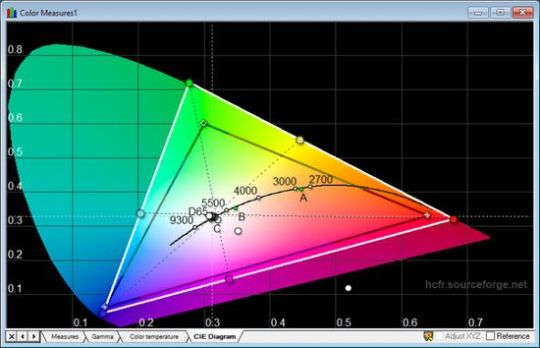
The HDR effect is most pronounced in the Bright and Standard modes, but for some it will be too exaggerated. “Home cinema”, “Cinema” or “Technicolor Expert” provide a less bright and saturated image, but more accurate color rendering and a soft sharpness effect. PROS - great picture; - innovative Picture-on-Wall design; - excellent HDR implementation; - simple and convenient WebOS platform; - Google Assistant and Amazon Alexa support; - excellent viewing angles; - surround, deep sound with superb detailing in all ranges. CONS - typical dependence of the maximum brightness of the OLED matrix on white in the frame; - no HDMI 2.1; - too high a price. This video shows the LG OLED65W8PLA. Read the full article
#10-bitWRGBOLED-matrix#BillionRichColor#FrequencyBasedSharpnessEnhancer#LGOLEDW8PLATV#LGOLED65W8PLA#LGOLED77W8PLA#LGThinQAI#LGTVPlusapp#ObjectDepthEnhancer#Picture-on-Walldesign#QuadStepNoiseReduction#TechnicolorExpert#UltraLuminancePro#α9intelligentprocessor
0 notes
Text
LG OLED E8 PLA TV Review

Of course, innovative technologies and high competition affect development trends in almost all segments of home appliances, including TVs. For example, plasma models did not withstand the competition and disappeared from the market due to the high cost of production. Most companies have abandoned the 3D feature due to limited content. On the other hand, LG presented at CES 2019 a new Signature Rollable OLED TV with flexible screen. 260 flexible OLED signage screens, connected together to imitate a waterfall struck the imagination of the most imperturbable viewers.

Nevertheless, the main intrigue in this segment remains in the competition between OLED and traditional LED (including Samsung QLED) technologies. Additionally, companies are actively using SMART technology, expanding the functionality of their TVs. ThinQ AI from LG and Roku Smart TV from TCL perfectly illustrate this trend. As known, some companies have reduced activity in the segment of OLED technology due to the high cost of matrix production, which significantly reduces the competitiveness of OLED TVs. But LG continues to actively develop this direction. OLED (organic light-emitting diode) technology uses its own radiation of diode when passing electric current. Accordingly, the OLED-display does not require LED backlighting, provides absolutely black and maximum contrast. As a result, they have a minimum thickness and maximum uniformity due to the lack of LED backlighting. Unfortunately, the high cost significantly limits their popularity.
LG 4K OLED TVs 2018
As known, modern models use RGB OLED or WRGB OLED technologies, which use, respectively, 3 or 4 subpixels. LG TVs are based on the WRGB OLED (white + red + green + blue sublixel) technology.

According to LG, the fourth subpixel reduces the production cost while improving brightness, contrast and color reproduction. LG produces panels on its own LG Display enterprises, which, of course, expands their possibilities for technology optimizing. As a result, the company was able to significantly reduce the price of its 2018 OLED models. Therefore, LG 4K OLED TVs became one of the sensations in 2018. The LG 4K OLED TVs 2018 includes the B8, C8, E8, G8 and W8 series. W8 is the flagship. The B8 has an α7 video processor, the other series use the more powerful α9. But, of course, this is not the only difference. For example, the series use different speakers. The series uses the popular Floating Glass or Picture in Glass design.
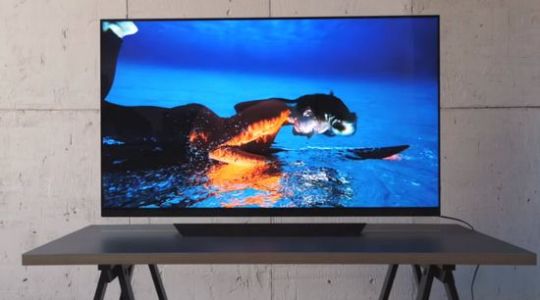
While watching, it creates the illusion of a TV that floating in the air. The video at the end demonstrates this innovative design. The 55-inch panel provides 4K resolution with superb image quality. The α9 video processor performs four-stage filtering the image from noise, ensuring smooth playback of the most highly dynamic scenes. In addition, the increased brightness increases the contrast required for high-quality playback of HDR-content. Support for Dolby Atmos Surround Sound technology allows you to use a soundbar or home theater, which will certainly significantly improve audio playback. LG ThinQ AI provides control of the connected periphery and high quality voice recognition.
Key features
LG OLED65E8PLA supports UHD-resolution (3840x2160 pixels). Its maximum brightness reaches 595 cd / m2 at a contrast level of 221: 1. Of course, these values correspond to the top level. The series has great connection kit, including two digital cable TV tuners, two digital satellite TV tuners, four HDMI inputs, LAN / WLAN, three USB ports, etc. WebOS 4.0 for Smart-TV already has pre-installed Facebook, Amazon Instant Video, Maxdome, Netflix and YouTube and supports further expansion. Unfortunately, the energy efficiency of the series corresponds to the average level (122W). For comparison, even the previous LG 55SJ8509 consumed only 84W. The series also includes a 65-inch LG OLED65E8PLA.

10-bit WRGB OLED-matrix with 4K resolution provides a large margin of brightness, which is important for high-quality playback of HDR content. The maximum brightness value reaches 400 cd / m2, and the peak - 800 cd / m2. As known, peak brightness can only be achieved under certain conditions - on a small bright object for a short time. Nevertheless, a huge 800 cd / m2 in a certain way characterize the matrix capabilities. Traditionally, the OLED panel provides gorgeous uniform deep black due to lack of backlighting. E8 supports almost all standards, including HDR10, Dolby Vision, Hybrid Log-Gamma (HLG), Advanced HDR from Technicolor, HDR10 Pro and HLG Pro. Unfortunately, this list does not contain HDR10 +. HDR Game mode easily supports enhanced brightness without increasing input lag. In addition, the matrix frequency reaches 120 Hz. Thus, these models may well be positioned as a game TV.
Image enhancement technologies
As known, distinct artifacts and pixelation degrade the image. LG uses several technologies to solve this problem, raising the level of even not very high-quality content. LG α9 processor in conjunction with the Quad Step Noise Reduction, Frequency Based Sharpness Enhancer, Object Depth Enhancer, Billion Rich Color and Ultra Luminance Pro provide excellent quality image for any content. Quad Step Noise Reduction effectively suppresses noise, improving the clarity and smoothness of image.

It replaced the previous two-step technology. Its effectiveness is most pronounced when upscale lower resolution to 4K during the content processing. Frequency based Sharpness Enhancer sharpens the image, reproducing fine details, textures and elements along the frame edges by controlling the refresh rate.
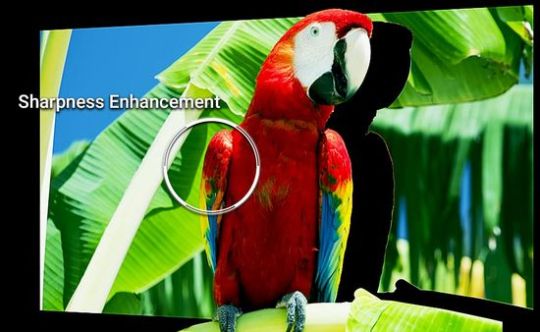
As a result, the technology improves the detail and realism of the image. The Object Depth Enhancer enhances the object depth by analyzing textures and frame edges to identify and highlight the main object in a frame.

True Color Accuracy Pro expands the color gamut by increasing the image saturation.

Of course, sometimes experts are skeptical about some of these technologies, considering them to be marketing. But LG OLED65E8PLA really provides the most saturated image with excellent color rendition and deep black color without distortion, without loss of brightness and contrast even at maximum angles. Of course, the quality of 4K HDR playback corresponds to the highest level.
Other
E8 has a set of preset picture modes with the possibility of their further adjustment by brightness, contrast, etc. Of course, calibration is significantly different for different modes. But in general, the factory settings correspond to a very high level. Technicolor expert demonstrated almost perfect color reproduction. The color temperature varies between 6500-7000K (6500K standard). The color error ΔE does not exceed 5. Traditionally, for an OLED matrix, the color gamut exceeds sRGB. 4.2 audio system with a total power of 60 W includes a subwoofer 20 watts under the TV screen. As a result, the sound is more powerful and voluminous compared to the B, C series. The models support surround Dolby Atmos, Clear Voice III and Audio Upscaler technology, fast One Touch Sound Tuning, syncing with other LG audio devices via LG Sound Sync and playback via Bluetooth. DTS decoder supports AC4, AC3 (Dolby Digital), EAC3, HE-AAC, AAC, MP2, MP3, PCM, DTS, DTS-HD, DTS Express, WMA and aptX codecs. The LG TV Plus app (Android and iOS) can replace the remote and provides content playback from your smartphone.
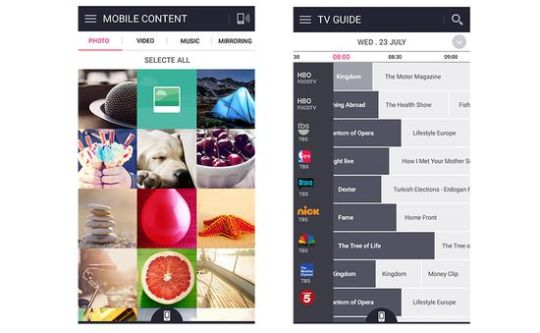
PROS: - OLED matrix; - superb image quality; - great sound with support for Dolby Atmos Surround Sound; - a wide range of image enhancement technologies; - a great connection set; - support for virtually all HDR-formats; - ThinQ AI with voice command support. CONS: - high level of energy consumption; - high enough price. Read the full article
#10-bitWRGBOLED-matrix#BillionRichColor#FloatingGlassdesign#Floatingillusion#FrequencyBasedSharpnessEnhancer#LGOLEDE8PLATV#LGOLED55E8PLA#LGOLED65E8PLA#LGThinQAI#LGTVPlusapp#ObjectDepthEnhancer#PictureinGlassdesign#QuadStepNoiseReduction#UltraLuminancePro#α9intelligentprocessor
0 notes
Text
LG TVs with new technologies at CES 2020 Review
As usual, CES 2020 attracted a lot of expert attention. Of course, the innovative 8K TVs aroused the greatest interest. Predictably, the development trend in this segment has not changed. AI video processing technology (8K AI upscaling), 5.1-channel audio and optimization of game mode remain the foundation of their improvement. In addition, companies continue to reduce screen thickness and increase screen-to-body ratio. For example, LG introduced ultra-thin Wallpaper and GX Gallery Series, and Samsung showcased the Q950TS 8K with bezel-less Infinity Design. Its screen-to-body ratio reaches an unprecedented 99%. Predictably, TVs with 8K resolution provoked a heated discussion about their certification. According to the 8K Association (8KA), certified 8K TVs must provide at least 7680 × 4320 resolution, peak brightness of about 600 nits, and support HDMI 2.1 and HEVC (H.265). As known, in 2002, a group of companies, including Hitachi, Matsushita Electric Industrial, Philips, Silicon Image, Sony and Thomson (RCA), developed the HDMI (High Definition Multimedia Interface) standard for video transmission. In 2017, the HDMI Forum introduced the latest HDMI 2.1 version. Its specs include a maximum bandwidth of up to 48 Gb/s, which supports 10K and 8K video transmission with a frame rate of 120 Hz. In addition, the standard includes support for dynamic HDR, gaming Game Mode VRR, HDCP 2.2, etc. The H.265 or HEVC (High Efficiency Video Coding) format uses the most efficient algorithms for compressing the video stream. Of course, certification provides an additional marketing advantage and companies are interested in obtaining it. However, this aspect contains some nuances.
8K Certification
Unfortunately, the disagreement between the two South Korean giants regarding the certification of 8K TVs remains unresolved. Several years ago, Samsung, Panasonic, Hisense, TCL Electronics and AU Optronics (8K panels) created the 8K Association. But, LG did not join 8KA by creating the International Committee for Display Metrology (ICDM) to certify 8K displays. Ultimately, a rather acute discussion arose between them. In particular, ICDM developed the Contrast Modulation test, which counts the displayed white and black lines with a width of one pixel. According to this technique, image clarity (resolution) depends on the number of displayed lines. ICDM substantiates its methodology with a reference to IDMS (Information Display Measurements Standard). According to LG, the presence of 33,177,600 pixels is not enough for the 8K model status, because the panel must also identify each pixel. Otherwise, an increase in their number loses its meaning due to the merging the brightness and color mixing. According to the company, test results LG 8K TVs showed Contrast Modulation (CM) up to 90%. The company calls this level “real 8K”. But the modern IDMS standard requires only 25% for images or 50% for text. Under the CTA certification, the 8K model must provide at least 50% CM. But opponents of ICDM object, that CM does not take into account the colors. Indeed, we are unlikely to see a black and white 8K movie. In addition, ICDM group recently softened LG’s previous position. However, this situation is not unique. For example, Epson has been proposing for many years to incorporate Color Light Output into projector specs, emphasizing the advantage of its 3-matrix 3LCD technology. But this professional discussion does not interfere with the market. Ultimately, the rating of 8K TVs will depend on the opinion of the consumer, regardless of sticker availability.
LG TVs at CES 2020
This year, LG introduced an unprecedented number of new TVs, including new 4K/8K OLED and NanoCell models. With the exception of the BX series OLED 4K and Nano85 series NanoCell 4K, all TVs use new powerful α (Alpha) 9 Gen 3 AI processor with AI Deep Learning algorithms. In particular, α9 Gen 3 supports AI 8K upscaling, AI Picture Pro, AI Brightness and AI Sound Pro technologies. As known, AI Picture Pro technology optimizes the image. Moreover, AI Picture Pro recognizes faces and text on the screen and improves the clarity of the facial features and the accuracy of the reproduction of skin tones. AI Brightness with a light sensor detects the ambient light level and automatically optimizes the image brightness. AI Sound Pro technology analyzes and classifies sound into five categories, choosing the optimal playback mode. This list includes music, movies, sports, drama and news. With the exception of HDR10+, TVs support all HDR standards, including HDR10, HLG and Dolby Vision. Last year, LG already offered models with expanded Nvidia G-Sync support. This year, the twelve LG OLED models have the built-in frame syncing technology providing gaming mode at 4K resolutions up to 120fps. In addition, LG has added several fundamentally new features, including Filmmaker Mode and Dolby Vision IQ (AI Brightness option).
Quad Step Noise Reduction and Sharpness Enhancer technologies
Of course, TVs use previous LG's Quad Step Noise Reduction and Sharpness Enhancer technologies. As known, digital video cannot have noise on the screen. LG uses this term because many have known it since the time of analog video. In fact, this technology corrects errors that occur during video encoding. This list includes sharp transitions of color shades, the appearance of a halo around objects, etc. A special program analyzes possible typical errors and corrects them when detected. But it is practically useless for video encoded with modern codecs with high-quality compression of the source file. Sharpness Enhancer enhances image clarity. This technology precisely separates the main object from the background images. Then the algorithm analyses textures and edges and performs video processing based on its results.
Conclusion
In general, CES 2020 has confirmed the dominance of innovative trend in consumer electronics. This year, LG introduced more than 10 new OLED and NanoCell series with 4K and 8K resolution. Today the price of last year's 88-inch LG OLED 88Z9 8K almost reaches $30,000. The cost of the new LG Signature OLED 8K ZX TVs, including 88-inch OLED 88 ZX PUA and 77-inch OLED 77 ZX PUA, are unlikely to be lower. They probably won't BestSellers, but perfectly illustrate the development of this segment. Оf course, the LG NanoCell 8K TVs will be more available. For example, the price of last year’s LG Nanocell 75SM9970PUA (75SM9900 in Europe) 8K TV today is slightly above $ 5,000. Apparently, Nano99, Nano97 and Nano95 versions of 8K NanoCell TVs will compete with Samsung Q950TS 8K and Sony Z8H 8K. Finally, many LG OLED 4K TVs, including ultra-thin models (Wallpaper and GX Gallery Series), rollable TVs (RX Series), 48-inch OLED48CXPUA of CX Series with Nvidia G-Sync built-in, and entry-level BX range traditionally claim to be BestSellers. This video shows the LG NanoCell Nano 99 8K at CES 2020. Read the full article
#AI8Kupscaling#AIBrightness#AIPicturePro#AISoundPro#ContrastModulation#DolbyVisionIQ#FilmmakerMode#HDMI2.1#LGGXGallerySeries#LGNano95#LGNano97#LGNano99#LGNanocell75SM9970PUA#LGNanoCell8KTVs#LGOLED88ZXPUA#LGWallpaperOLED4K#QuadStepNoiseReduction#SharpnessEnhancer#α9Gen3AIprocessor
0 notes